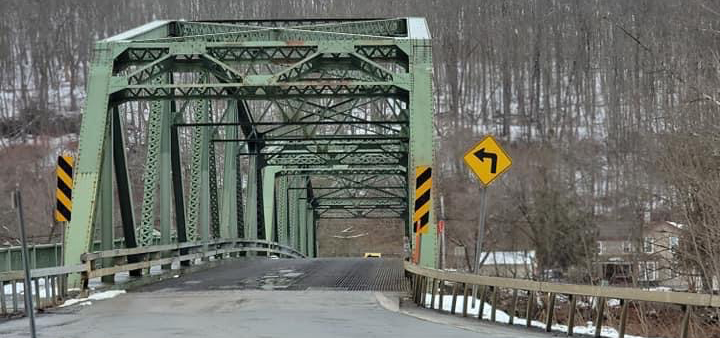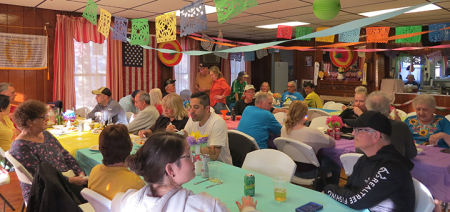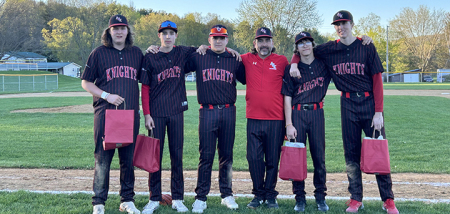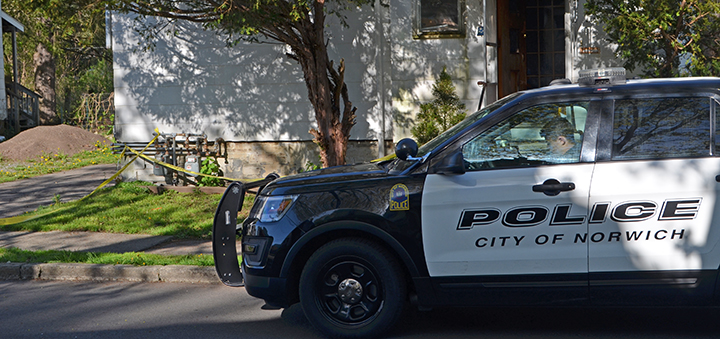NY To Replace Historic Rt. 79 Bridge Between Broome And Chenango Counties
Published:
March 27th, 2023
By:
Kelli Miller
 The old Rt. 79 bridge in Fenton will be demolished once the new bridge is complete. (Submitted photo)
The old Rt. 79 bridge in Fenton will be demolished once the new bridge is complete. (Submitted photo)
GREENE — After two years of planning the New York Department of Transportation is moving ahead with a new bridge construction project in the Town of Greene, along the border between Broome and Chenango County.
New York State Department of Transportation (NYSDOT) announced on April 4, 2021, that construction began to replace the existing bridge carrying NY Route 79 over the Chenango River in the Towns of Fenton and Barker in Broome County, with a new bridge realigning NY Route 79 approximately 0.6 miles upstream in the Towns of Greene, Fenton and Barker, which will be located in both counties of Chenango and Broome.
According to presentation by the NYSDOT, the state and federal funded $12.6 million project is scheduled for completion fall of this year.
NYSDOT Region 9 Public Information Specialist Scott Cook said, “ Since Construction began, we have not run into any unforeseen challenges and the project remains on schedule.”
The new structure is a two lane multi-girder bridge approximately 470 feet in length with 11-foot travel lanes and 5-foot shoulders on both sides. A new signal will be at the intersection of NY Route 12 and newly aligned NY Route 79 in the Town of Greene and will have turning lanes, bike lanes and crosswalks.
Fenton Town Supervisor Gary Holcomb said, “After anticipating this project for several years, we look forward to having this new bridge that is designed to the latest standards for vehicle, pedestrian, and cycling traffic. It will improve traffic safety, improve access between northern Broome County and Chenango County connecting Route 79 and Route 12, and provide improved access to existing cycling routes and other recreational activities including Chenango Valley State Park. It will be a great addition to the Town of Fenton.”
The railroad crossing is being improved and upgraded to a public crossing. A new one-way stop intersection will be constructed at the bridges approach in the Town of Fenton. Private driveways will be modified to provide access to the new highway. Landscaping to the area will preserve environmental and visual expression.
Traffic will be maintained on the existing bridge during construction but once construction is complete, the existing bridge will be demolished. New signage will be installed to alert motorists of changes in travel patterns and names of roads.
The public railroad crossing and traffic light that currently provides access to River Road and River Lane will remain. NYSDOT will re-pave the old alignment of NY Route 79 between existing bridges and then transfer ownership and future maintenance responsibilities to the Towns of Barker and Fenton in their respective jurisdictions.
The Chenango River is a tributary to the Susquehanna River. It is protected by New York State Environmental Conservation Law as a navigable water and is protected to sustain fish populations, provide high water quality, and offer contact recreational opportunities.
NY Assemblyman Joe Angelino said, “Replacing this bridge is an important project for the people in my district. I am always pleased to see more investment in infrastructure in our region. Sound roadways and bridges are important to keep our communities and economic engine moving. I look forward to its completion.”
The NY Route 79 Bridge provides an important connection for local traffic traveling to cities of Ithaca and Cortland. Without this bridge connection the DOT reported the nearest crossing of the Chenango River is 7.9 miles downstream and 8.4 miles upstream in the Village of Greene. Thus, the need to provide a crossing in close proximity to the location of existing bridge.
NY State Senator Frederik J. Akshar said, “Replacing and repairing our aging infrastructure is a cornerstone of creating economic development and opportunity for our upstate communities. I applaud our hardworking men and women at the NYSDOT for all they do to keep our roads and bridges safe for New Yorkers.”
The Metropolitan Planning Organization (MPO) associated with this project is the Binghamton Metropolitan Transportation Study. MPOs are established for urban area with the populations of 50,000 or more, and are responsible for ensuring that federal-aid transportation projects in the metropolitan area resulting from a continuing, comprehensive and cooperative transportation planning process. For information regarding New York’s MPOs, visit http://www.nysmpos.org/.
Seven alternative proposals for the bridge location were considered by the NYSDOT with a few stakeholders expressing they would like the proposed bridge to remain in the same location as the existing bridge. These alternatives were evaluated yet eliminated due to safety concerns. Others desired the existing truss bridge be retained for pedestrian and bike use. Alternative D was selected as the most beneficial for bridge structure, length and width, traffic flow and safety.
NYSDOT powerpoint discloses conditions, issues and concerns of the old bridge. The continuing deterioration of bridge members, bearings, open grate deck and expansion joints are amongst those issues. The roadway elements do not meet current design standards along with the sharp approach curve and slight distance and shoulder widths. Accident rates on NY Route 79 are at a higher rate than state average.
The Conceptual Stage Relocation Plan for bridge replacement project in Town of Greene, Chenango County and Towns of Barker and Fenton, Broome County was signed in 2020. The introduction states the study of proposed alternatives considered to address the structural deterioration and safety on NY Route 79 over the Chenango River. The bridge was built in 1936 and received a deck replacement in 1978. Approaches were rehabilitated at that time.
The Final Design Report noted since 1978, multiple repairs were made. Structural deficiencies included deterioration of bearings, bridge seats, abutment stems, wearing surface structural deck, primary members, paint system, joints, pedestals and pier capbeuam. There is also noted severe cracking in the begin and end joints, exposed rebar in the concrete subheads and deteriorating approach pavement. The bridge rail is in poor condition. And Scour is also present on footers and pier.
According to the NYS DOT report, non-Standard feature include roadway and shoulder widths and structural capacity. The curves and sight distance are also deficient. For example, the standard horizontal curve radius for Route 79 is 652 feet; the existing radii for the western and eastern approaches are 60 feet and 200 feet, respectively. These non-standard features have contributed to the higher accident rate.
The Final Design Report states the purpose of this project is to address the existing structural and geometric deficiencies of the NY Route 79 Bridge over the Chenango River, while providing a crossing on or in close proximity to its existing location.
Additional purposes of the report analyzed and compared relocation problems created by residential displacement, and an auxiliary business. Considerations for different alternative locations for the bridge were drawn up and reviewed. Other Considerations that went into the project were those of Environmental & Visual Impacts, existing Historical Bridge and Cultural Resources, Railroad Crossing, Property Acquisitions and Cost.
A historic bridge listed on, or eligible for inclusion in the National Register of Historic Places has been identified as the existing bridge at NY Route 79. It is eligible for inclusion in the National Historic Register.
The impending removal of the historic bridge can contribute to the project’s adverse effects on historic properties. The structure was offered free of charge to the counties and towns surrounding the project site but no party was interested in ownership of the bridge, hence the proposal for demolition.
The Department, in coordination with the Federal Highway Administration (FHWA), conducted Section 106 consultation with seven Tribal Nations. Tribal Nations involvement aided in identification of historic properties. Two letters which included the Finding Document and Historic/Cultural Resource results were provided to all seven Tribal Nations for concurrence with the Finding Document.
Properties impacted by the project include The Town of Greene with eight affected property owners, eight fee acquisitions, three temporary easements and one permanent easement. In the Town of Fenton, there were four affected property owners, four fee acquisitions, one temporary easement and two relocations.
Purchases of dwellings and assistance for relocation were offered. Owners were contacted by phone or in person and moved forward with the acquisition process. Day to day relocation assistance, interviews for needs and preferences, a booklet “If you Must Move… We Can Help!”, moving expenses and possible supplemental housing benefit services were supplied.
Business moving expenses included moving expenses, re-establishment expenses up to $25,000 or payment “in lieu of” reestablishment & moving expenses. Two businesses were impacted by project.
Chenango Shores Campground, located at 109 Chenango Shores Lane, has had a reduction of rental camping spots along the eastern portion of the Campground. The new bridge alignment passes through and over a small part of the business to support the Alternative D construction. The owners of the campground attended the public meeting for property owners on March 28, 2019 and no negative comments were received.
The Chenango Valley Honey Farms business, located at 6320 NY Route 79, was acquired as part of the bridge construction project. A letter from the owner indicated the property serves as a residence as well as a farm business. The property owner indicated this is where all honey retail products are processed. Additionally, it is used to raise queen bees for sale. The owner also sent a letter indicating she would like to be offered relocation assistance for both home and business. An evaluation of the use of property and land owners input established relocation benefits.
For further information please contact Public Information Specialist Scott Cook at scott.cook@dot.ny.gov; or by mail at NYSDOT Region 9, 44 Hawley Street, 11th floor, Binghamton, NY 13901
Author: Kelli Miller - More From This Author
Comments






